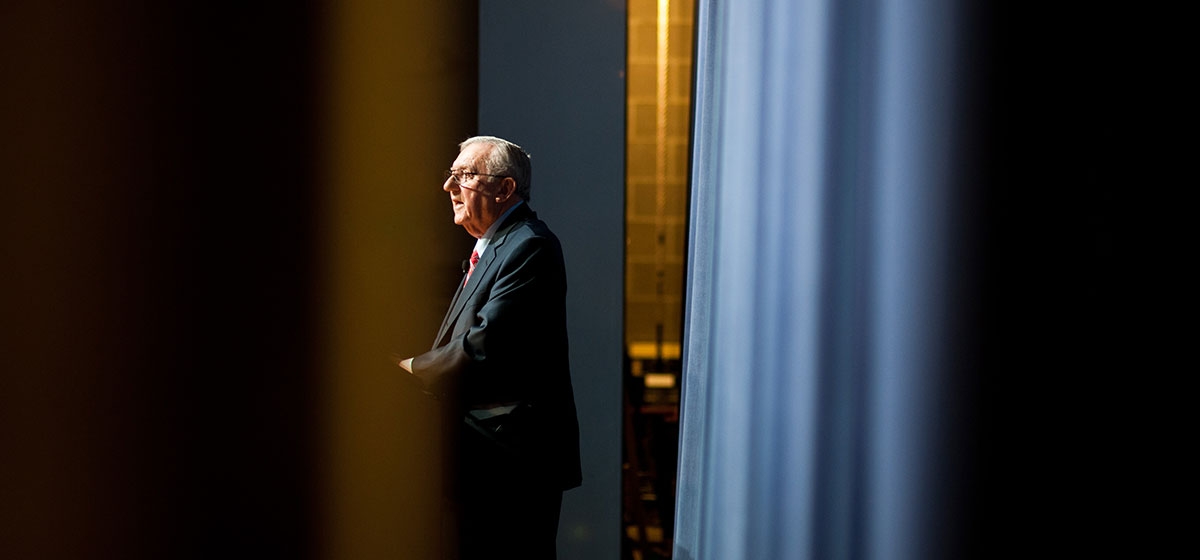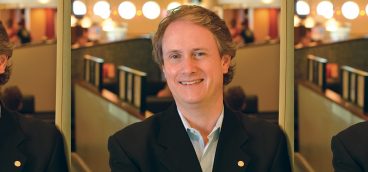
I am convinced that I am absolutely, positively the luckiest man in the world.
During my business life, I seemed to be at the right place at the right time. When I graduated from college in 1953, metallurgy was at the beginning of a tremendous technology and manufacturing change, and I was part of it, because I was born in 1931. And because I chose to work at Allegheny Ludlum. It was a major producer of stainless steel and specialty metals and decided to enter the titanium business in a joint venture. The U.S. government was providing financial support to encourage American companies to invent processes for manufacturing titanium in production quantities for use in military aircraft. I was assigned to work on titanium, and the company—Titanium Metals—became one of the largest titanium companies in the world.
I had told my new wife at that time that I would work for three companies, and I did, with a twist. Two of my bosses at Allegheny Ludlum left to go to work for other metals companies. Each, over 10 years, recruited me to work for their companies, first at Latrobe Steel and then at Republic Steel. After two years at Republic, I was named assistant general manager of a 10,000-man steel operation, which also produced specialty steel and titanium. I was 33. I had been presented with a production and technical challenge and turned a $30 million annual loss into a significant profit and wound up with a job I probably wasn’t ready to assume.
So, to be successful, be lucky. And be presented with challenges which you are able to turn into solutions. It is difficult to “shine” if you don’t find solutions to problems which have significant economic consequences.
Also, be lucky enough to have bosses who believe in you. My last boss at Republic, when I was named assistant general manager, was a man who never went to college and who worked his way up to general manager. When asked who he wanted as an assistant, he said, “I want Dick Simmons.” He was told that Dick Simmons was too young. He said, “If I can’t have Dick, I don’t want the job.” Talk about luck. It could only have happened because two of my bosses left Allegheny Ludlum and subsequently hired me.
In 1968, at Republic, I developed a bleeding ulcer and almost died. When I recovered, I told my wife that the culture at Republic was less than enlightened. I had the responsibility to build the largest electric furnace melt shop in the world, and when I asked for approval to hire some really bright engineers to run it, one senior official said, “Dick, we don’t want those ‘wise ass’ MIT graduates. We want graduates from Podunk U. who will stay with us for 30 years and not make waves.” He forgot that I had graduated from MIT.
At the same time, when I was recuperating from my ulcer surgery, the chairman of Allegheny Ludlum called to ask if I would return to Allegheny Ludlum as vice president. In 1971, two years later, I was made president. Talk about luck.
In 1978, Allegheny Ludlum’s board of directors decided to sell the company, and after searching the world, they couldn’t find a buyer. I was given permission to put together my own leveraged buyout. We did, and the rest is history. When we closed the purchase, the prime interest rate was 21 percent, and we were paying 22.5 percent for our debt.
But the roulette wheel in the sky landed on my number. We took Allegheny Ludlum public in 1987—five months before the stock market crash of October 1987. Allegheny Ludlum is now a subsidiary of Allegheny Technologies, one of the largest specialty metals producers in the world, with sales of roughly $5 billion.
I wasn’t the smartest guy at MIT, but fortunately I was smart enough to recognize that there are a lot of really smart people out there. To be successful you need many attributes to build a career and climb the ladder. Luck is a key ingredient.
Life’s truths
When I was manufacturing vice president of Allegheny Ludlum, I didn’t know what was going on. I didn’t know what was going on at Republic Steel or at Allegheny Ludlum until two weeks into the following month. Nor did anyone else. Back then, the primary purpose of the accounting division was to close the books each month. Remember, this was 40 years ago.
Life’s truth no. 1: If you can’t measure it, you can’t manage it. As manufacturing vice president, working with the accounting department, we devised a system which would permit us to measure the variable costs of every item we produced. It took three years, but we developed standards for every operation on every order. And we could report variances every week and in certain operations every day. We disseminated that information to every production supervisor so everyone knew where the problems were. And each year, all of the favorable variances which had been generated the prior year were incorporated into the following year’s standards. This is called continuous improvement. Everyone understood the system, and every Monday morning, the production vice president would tell all the key senior managers how we were doing that month to that point. This was a great way to help managers understand their jobs and do better.
Life’s truth no. 2: If you give good people good and timely information, they will do great things. Installation of this information system was one of the most important strategic decisions I made in my entire career.
Life’s truth no. 3: Look beyond your job. Ask yourself how your job affects other departments. For example, if you can’t produce a quality product on time, will your sales department get another order?
Most CEOs don’t have the opportunity to make more than a handful of truly strategic decisions in an entire career. I can count on two hands all of the truly strategic decisions I had the opportunity to make in 27 years. And one is, “if you can’t measure it, you can’t manage it. “ And chances are, if you can’t measure it, you can’t develop managers—and perhaps you won’t survive. As late as 15 years after we installed this system at Allegheny Ludlum, a major metals company visited us and asked to see the cost system they had heard about. After seeing it, they asked how we were able to get approval to install such a system. Answer: I didn’t ask.
Life’s truth no. 4: Think through issues and be prepared to disagree with the conventional wisdom, even when it is your boss who is saying it. When I was told that I was going to be made president, the outgoing president said to me, “Richard, the only problem with you is you have never been fired.” I plead guilty to that.
Life’s truth no. 5: All specialties become commodities over time. It doesn’t matter whether it is computers, drugs or specialty steel. What this means is that you should take advantage of the higher profit margins of specialty products and be prepared to take price reductions for your products as specialties become commodities. When I became president in 1971, there were eight competitors producing flat rolled stainless steel. By 1983 all but one were gone—shut down and out of business. We have new competitors, foreign companies who had built plants in the U.S.
Life’s truth no. 6: In a global economy you’d better be cost competitive—sooner rather than later. For example, in 1970 Allegheny Ludlum produced stainless steel in coils mostly two feet wide. The reason was simple: early rolling mills for stainless steel were two feet wide because it is a difficult metal to roll. But newer rolling mills could be four feet wide and now five feet wide. We had only one mill that was four feet wide. Now with more powerful mills, it takes the same amount of labor to roll a coil four feet wide as it does to roll a coil two feet wide. Thus, the direct labor component is half for four-foot wide coils. And there is only half the percent loss of metal from the edges of the coil. And this excludes the fact that the largest customers increasingly wanted wider material.
At the time there was a brand new stainless steel plant, which a new producer had built and from which they couldn’t successfully sell the output. We bought the plant for $7 million. No one else bid. We estimated it was worth $30 million. I repeat: you have to be lucky.
Life’s truth no. 7: In capital-intensive businesses like ours, you better figure out how to get a return on capital employed which exceeds the cost of capital. That purchase of the four-foot-wide plant is still, I believe, the most profitable plant in the company on a return on capital basis. The next plant for stainless steel that Allegheny Ludlum built in the 1990s cost over $200 million.
So, just what does the CEO do? There has to be more than just putting in an information system—and indeed there is. First, in today’s world, the CEO must fight for his space. The current regulatory world that requires his signature or his authorization, or meetings to discuss that which is of truly little importance—this consumes far more of the CEO’s time than in previous decades. His day is filled with unproductive tasks that lend little to the management of the business. The CEO must fight for time to think about really important issues.
My point here is that important, difficult strategic decisions, for me at least, can rarely be made at the office. You can gather facts at the office, discuss the differing opinions, but only the CEO can make the final decision. And that takes time. Let me give you an example.
Allegheny Ludlum was a pure play in specialty steel. We had a master contract with the United Steelworkers. In 1994, we had a 70-day strike which cost us $100 million pretax. I was the CEO. Those were the facts. So what should I do? We could do nothing; we could sell the company; or we could buy a company which would help us diversify but remain in specialty metals, which we understood. If possible, we could buy a company remaining in specialty metals and perhaps deal with our greatly underfunded pension plan.
And this is where “luck” comes in. There was such a company, and its name was Teledyne, a conglomerate which had significant specialty metals activities and an overfunded pension plan. And a corporate raider was after them. Initially, I tried to acquire their specialty metals activities, but they refused. So I proposed that we merge the two companies. They accepted. Rich Harshman, the current CEO of Allegheny Technologies, was a Teledyne employee.
What were the trade-offs? We would possibly give up control of our future as the largest shareholder. I was the largest shareholder, and my holdings would decline significantly because of the dilution of exchanging their stock for our stock. There were obvious difficulties in merging two companies with different cultures and achieving the synergies we thought existed. That, indeed, was a strategic decision. We studied each of the non-metals divisions and ultimately decided to sell or spin off all of the non-metals activities—either selling or taking public two of the largest divisions.
As a result, Allegheny Technologies became one of the largest specialty metals companies in the world with sales of roughly $5 billion. I permitted the original Teledyne companies to use the name Teledyne, and it is on the New York Stock Exchange as TDY. We also spun off Waterpik as a public company, which was ultimately acquired by another personal care company.
There are several more strategic decisions which faced us over the years, and I will only talk about one more.
In 1980, the parent company of Allegheny Ludlum Steel decided it did not want to remain in the specialty steel business. But they could not find a buyer. At the time I was executive vice president of the corporation, and president of Allegheny Ludlum Steel.
I asked for and received permision to put together my own buyout. So with the support of the management team, I was able to put together one of the largest leveraged buyouts ever done up to that point with financial support from the parent company. The prime interest rate was 21 percent; 1980–84 remains as one of the worst recessions since the Great Depression until now. We survived and prospered with a great deal of discipline and “luck.” And ultimately, the management team and other investors got rich.
Life’s truth no. 8: Take advantage of opportunities when presented. They come along all too infrequently.
But what else does a CEO do? Well, he sets the bar for performance, and the bar must be set high. Being a CEO is both a teaching and learning experience.
You have to field your best team. You have to be able to identify the best players on the team. The information system provides a yardstick by which to identify them. Then you have to be able to develop them so they’re ready to move up in the organization. They must buy in to a concept which demands excellence, and they must have the passion to inspire their organization to buy in to excellence as well.
I believe that the ability of the organization to accept change rapidly is what separates companies which are successful from others which are not. I call that V of C—velocity of change. Mature companies in mature industries, which we were, do not change easily or rapidly. The CEO must drive that process.
The values of the organization are set at the top. The entire organization looks up to see what the CEO is doing—not what he or she is saying. So for those of you who aspire to be a CEO, remember the burden that you carry—not just to make the handful of strategic decisions you will have the opportunity to make, but also the values, the ethics, and the moral compass of the company you lead. That will be how you will be remembered.
Finally, choose the company you work for very carefully. And if you want to be a CEO, make as certain as you can that youth won’t hold you back. Being at the right place at the right time is the magic sauce essential for success.
Editor’s note: Richard P. Simmons was the inaugural speaker in a quarterly CEO speakers series hosted by Pittsburgh Quarterly and Robert Morris University on its Moon campus. The above is his speech, slightly abridged.






